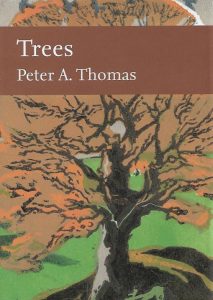 Trees by Peter A. Thomas. No. 145 in the New Naturalists Series. Harper Collins. 2022. ISBN 978 0 00 830451-5 9 780008 304515 £65 502pp.
Trees by Peter A. Thomas. No. 145 in the New Naturalists Series. Harper Collins. 2022. ISBN 978 0 00 830451-5 9 780008 304515 £65 502pp.
As NN books go, this is one of the thickest and heaviest challenging various titles such as ‘Fungi’, ‘Bird Migration’ or ‘Woodlands’. At 502pp it is curiously thicker than Oliver Rackham’s ‘Woodlands’ at 609pp.
The author is now Emeritus Reader at Keele University (where he is curator of the National Collection of cherries) and an Associate of Harvard Forest at Harvard University, USA so he knows a thing or two about trees.
The book is a mine of factual information. One that stuck me was that ‘250 litres of petrol can be produced from one tonne of wood’ i.e. biodiesel, so why is not every country doing it?
There are 16 chapters from the ‘value of trees’ to the ‘future of our trees’ (UK and Ireland included). The subjects in the book are all arranged through the year from spring growth, ‘the annual bounty’ with seeds and fruits, ‘the Annual Show of Autumn Colours’ and how trees address cold winters and storm damage. As my PhD was on carotenoids I would have a slightly different opinion on their role in autumn colour. There is a chapter on pests and pathogens and the future of trees. All are a good read, to dip into or not; it is such a big book that forays can be had into all sorts of tree information, from the longevity of trees in Britain or in the world, to elm bark beetles, and the latest on ash dieback disease.
There is an excellent section on native and introduced species, with tables and explanations. With 32-35 native tree species in Britain, there are 220 of the commonest and obvious naturalised trees and shrubs in Britain, either neophytes (after AD 1500) like Horse Chestnut and Turkey Oak, and archaeophytes (introduced earlier) like Sweet Chestnut or Service trees. There is also an interesting section on associates of trees, picking up from Richard Southward’s classic 1960s work.
The future of trees looks bleak, but Thomas is upbeat about the efforts of global REDD programme (Reducing Emissions from Deforestation and Forest Degradation). He launches straight into the angst of the Anthropocene and explains that the weight of things made by man now exceeds the collected weight of man on earth, and the effects on the environment (land and air) and the effect on trees ’Over 15,500 (30%) of the world’s estimated 60,065 species of tree are now threatened with extinction, due to agriculture, livestock farming and forest degradation.’ With 142 species becoming extinct in the last five years up to 2021, the UK now has 15 endangered trees species that are ‘priority species’ which are included as Biodiversity Action Plan (BAP) species. The figures vary according to whether you include Sorbus, Salix and Juniperus as species or clones. Thomas lists Ten golden rules for reforestation… mostly common sense for land owners, foresters and nature conservationists, such as ‘plant species to maximise biodiversity’ (No 6) with a little commercialism thrown in ‘make it pay’ (No 10).
One take-away fact is that Thomas says that ‘planting trees is not a silver bullet for solving climate change’ even though everyone except professionals seems to think that it solves everything and ticks the ‘net gain’ algorism.
The photographs are mostly those of the author augmented with others from around the world, Europe, Australia, New Zealand and North America. Typically for this series there are references and species and general indexes.
For tree enthusiasts this tome is a must. There is never too much information about trees, and it is not surprising that a lot of recent work, facts and figures mentioned in the book, have come from recent research studies. So it is very much up to date. The next tree book in the NN series might be on greening the planet post Anthropocene …. planting more trees.